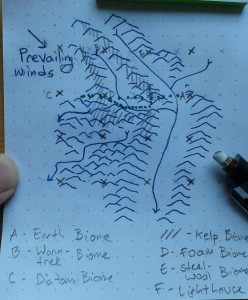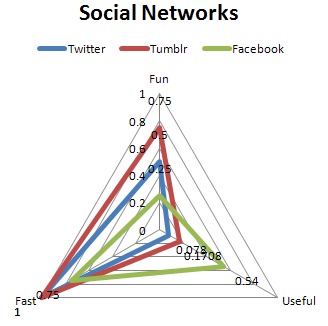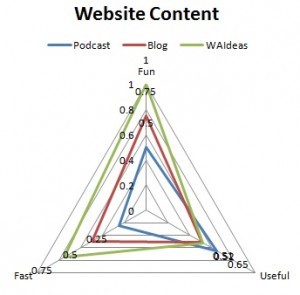Daniel M. Bensen's Blog, page 86
July 26, 2015
Done III, return of the son of Done!
The third and final read-through of Charming Lies is done!
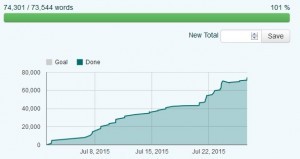
If you look closely, you can see where July’s weekends were (all play and no work!), when we sent my daughter off to her grandparents’ village, when I decided to tear out and re-write the ending, and when I was violently ill.
So, I’m going to change things around a bit from comments from my agent and a few last beta-readers, but I’m calling it now:
CHARMING LIES
Final Draft Finished 7/26/15 in Sofia Bulgaria
27 chapters, 204 pages, 74301 words
First Line:The ropes around him pulled tight. Timurhan bin Metin stiffened his muscles and thanked All-Merciful God the smugglers had been too stupid to kill him.
Done while listening to:

July 23, 2015
A Grass-fed Man
There’s two ways I could go about giving myself the ability to digest cellulose (the major structural component of plants).
The first is I could take some cultures of human gut flora (https://en.wikipedia.org/wiki/Gut_flora) and try to grow them on a diet of cellulose. Come back in 11 years or so and some of them are sure to have cracked the problem. Maybe I can borrow some of Richard Lenski’s equipment (https://en.wikipedia.org/…/E._coli_long-term_evolution_expe…). Anyway, you’ll notice that this solution isn’t genetic engineering at all: it’s selective breeding, breeding a microbe (or microbial community) to break down cellulose. If I introduced that community into my gut (by means of some extremely expensive 11-year-old yogurt) I might gain the ability to digest cellulose (assuming that the new bacterial strains replaced my native ones, and that their breakdown of cellulose produced some byproduct that I could make use of). If everything worked perfectly, I’d have that ability forever.
But why be content with boring old Decent With Modification? Why not find something that digests cellulose already and splice its genes into the Lactobacilus or Escherina or whatever that I’ve already got? A good candidate would be Fusarium solani (http://www.pnas.org/content/105/35/12932.full) , a fungus that seems to play some role in the breakdown of lignin (an especially tough cellulose compound that makes up wood) by termites? Termites actually have a whole slew of specialized gut bacteria (some of which have even SMALLER bacteria living inside them: http://www.pnas.org/content/105/35/12932.full) which work together to break down cellulose. It’s not a simple process, and would take a project on par with the moon-landings to port into the human gut, but let’s just assume that this fungus carries the key, and we can just smoosh that key into some yogurt and drink it. Assuming life were that simple (ha!) you’d get the TEMPORARY ability to digest wood, until the modified bacteria were out-competed by your native gut-flora or bred themselves back to normal.
Breaking down lignin is expensive (metabolically costly, in bio-terms) and the bacteria that aren’t burdened with the genes to do it will enjoy a selective advantage. Over time, they’ll come to outnumber the bacteria that can digest lignin, and you’ll be back to where you started. You might stretch out the process by eating lots of sticks and leaves, flooding your system with cellulose so that nothing else is available…and suffer some pretty nasty nutritional deficits.
And why bother? Your doctor and your Monsanto sales rep will be happier if you eat a cup of $50 Yogurmite(R), eat grass for a month along with the rest of your normal diet, then fork out another $50 next month for your next cup. Like the human gut and its microbial ecosystem, capitalism is a complicated system that we don’t want to mess with.

July 21, 2015
Losers and Losers
Put this one in the “wish English had a word like this” box.
Google-translate the English word “loser” into Bulgarian and you’ll get two translations: zagubenyak and karak.
The first means literally “one who loses” (za-gub-en-nyak = FILLING-lose-PARTICIPLE-person), and it refers to someone who’s in their sorry state because they are foolish. Karak (maybe from Turkish kara=black?) is a person who is unlucky, who fails through no fault of their own. What a charitable assumption to make 

July 15, 2015
The Nun and the Ern
Working on some background for Junction, in which a wormhole in New Guinea leads to an alien planet. Of course, there are people living around the wormhole on both ends, called the Nun (nearside) and Ern (farside).
The Nun are based off of real-world Mek peoples (specifically the Ketengban of eastern West Papua). Here’s some information about their language.
Nun language (related to the Mek languages of eastern West Papua, specifically Ketenbang)
Phonology
/i e a o u/
/pw t ty k, b d g, m n ng/ /v f s//r//l y/
Sample name: “Tyaney”
Syllable formation is Vowel or Consonant-Vowel, with Consonant-Vowel-Consonant possible at the end of words.
Vocabulary
pwal – shaman
bak – marsupial
enepuk – verb to do
uam – pig
sembu – a sacred stone
mungguat – a ghost or spirit
Yeli – the world-pillar that was destroyed. The kembu stones are splinters of the Yeli
ousa – taboo
dung – worm
babi – incest
kubilon – uninitiated person
Grammar
Post-modifying. Adjectives follow the noun they modify.
Dung Yeli – The Rainbow Worm (lit. Worm World-Pillar)
Sentence structure is Subject Verb Object by default, although there is considerable flexibility.
Wit bal-enepuk – One initiates boys into manhood (lit. Boy cut-off-do)
Generally isolating language, but exhibits an elaborate system of agglutination in verb formation.
“Ern” language (related to Nun-Mek)
Phonology
/i e a o u/
/p t k, b d g, m n ng//s//l y/
sample name: “Sing”
This will probably change as I continue my research
See also:
Sela Valley: an Ethnology of a Mek Societyby Jan A. Godschalk

July 14, 2015
Progress
So I’ve been posting some stuff about my writing strategy. The reason is, when you start shopping manuscripts out in September, right around now is when the rejections start coming in. The good news is that this year’s crop of rejections (for New Frontiers and Petrolea) have been more positive than ever before, the bad news is that they were rejections.
What do I mean when I say my rejections have gotten more positive? All of the editors who rejected me said things like I’m a good writer, or I’m someone to keep an eye on, and even though they can’t publish what my agent has sent them, they want to hear about the next thing I write. That isn’t just empty praise—these are the people who sent me form rejections for my first book, shocked silence for my second, and uncomfortable throat-clearing for my third.
The improvement in responses tells me that, by writing more and talking to other people about writing, I am making progress toward my goal of being published, but I haven’t hit that threshold of “yes, this is a good book.” It does seem like I’m getting closer. Each round of rejections I get is more complementary than the ones before, and I know I’m learning things as I write and talk to my wise and wizened writing elders.
New Frontiers was better than anything I wrote previously, but Petrolea was better than New Frontiers. Charming Lies is totally different from anything else, so the mistakes I made with it are at least new ones. Junction has a much firmer base than anything else I’ve written and I am cautiously hopeful that I’ve solved the basic problems of plot and comprehensibility and I’ll be able to focus my energy on not just making a readable book, but a good one.
Here’s to progress.

July 12, 2015
100 Revolutions with Carrie Patel
http://www.thekingdomsofevil.com/wp-content/uploads/2015/06/100CarrieJuly-13.mp3
I’m talking with Carrie Patel about her new book, Cities and Thrones and revolutions.
You may remember Carrie Patel and The Buried Life.
Revolutions often don’t go as planned
We’ve been seeing a lot of dystopias
The Haitian Revolution and the French Revolution.
Fantasy Underground Bulgaria
Bulgaria’s J-curve (check out what happens in 1990)
Incubating a story
The beginning of the book gets more revision than the end
Bare Branches in India and China
Pillars of Eternity by Obsidian entertainment, which has lots of words
Dan’s envious of the people working on Pathfinder
See if you can pinpoint the point during the conversation at which Dan drank enough coffee to gain self-awareness

July 9, 2015
Forced Servicization
Starting with Russia in the nineteen-teens and expanding to Eastern Europe post-WWII, the Soviet Union took a bunch of agricultural countries like Poland and Bulgaria and forced them to industrialize. It financed this by de-industrializing (re: strealing) everything that wasn’t nailed down in Central Europe, but anyway…
What if someone did that today? Clamped down on an industrial, industry-based country like Saudi Arabia or China (or indeed Russia) and forcing them to transition to a next-gen service economy? What would that look like?
This change couldn’t happen now, because we still don’t exactly know how service economies work, or how they will evolve. But once we transition to the next big thing (a nanotechnology-assisted intellectual rights economy?) we’ll know enough about service in hindsight for it to be possible to shove entire countries through the transition.
If the transition went like the transition from agriculture to industry in Bulgaria, it would be both great and terrible. Oil fields dug up and replaced by enormous call-center arcologies, helping clients around the world troubleshoot problems too peculiar or marginal for AIs to handle. Wide-scale demolition of factories to make way for entertainment jungles to cater to the needs of tourists with ever-more specific tastes. Massive public spending on the arts to create content, any kind of content, that people will pay to experience.
Well, there goes my buzzer. Time to pack up and head back into the story-mines.

Maps!
I have a terrible confession to make. I don’t care for maps at the beginning of books. It’s like F do I care whether this made-up country is north or south of this OTHER made up country. I’m not going to remember those city names after I finish reading, I hope you know that. And you didn’t even get the plate tectonics right.
But it turns out that in some circumstances maps are necessary for the author if for no-one else, as I realized when I tried to plot out a book about people hiking through various alien biomes. I really really had to know where all the biomes were in relation to each other and the hikers’ goal.
So I cheated:
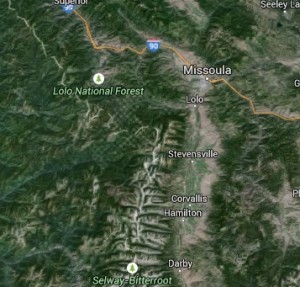
Look familiar?
I knew I wanted to base this story loosely on the Lewis and Clark Expedition, specifically in their crossing of the Lolo Pass, so what better place to start than the Lolo Pass itself?
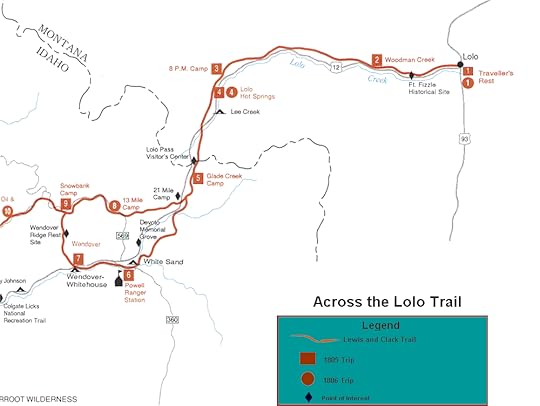
Not a bad likeness
The result is something that seems to work hyrdo-geologically and fulfills all the plot points of my story. Once again:
X’s indicated known or presumed wormholes. Arrows indicate rivers. Prevailing winds are from the Northwest.
The story begins at point A, where the wormhole to Earth is situated. Generations of native humans have extended the Earth Biome to the southern tip of a valley. Terraforming has been harder going to the north, where the rivers bring foreign organic material from several wormholes. The Wormtree Biome is the most vexing current problem.
Our heroes fly directly east from the settlement around the Earth Wormhole, over two mountain ranges and the Continental Divide, before their plane crashes, stranding them in the Diatom Biome. Their hike back east includes six alien biomes, monster-fighting, explosions, mountain-climbing, hunting, being hunted, sex, murder, white-water rafting, intrigue, espionage, international exo-geopolitics, terrorism, robots, and The Bomb in more-or-less that order. Try to guess where they fit on the map!

July 7, 2015
Oh, gaita!
Shocking news! The traditional bagpipe of the principality of Asturia in Spain is called the gaita. Same with Gallician and standard Spanish (where it’s also called cornamusa).
The traditional bagpipe of Bulgaria is the gayda, which is more or less the same with the word in Serbo-Croatian and Albanian.
I can’t find any cognates in Germanic (usually something like bag-pipe), Romance (usually something like cornamus), or Slavic (something like dudy). So what’s up with these two pockets of gaita/gaida on the opposite ends of Europe? Is this the old Celtic word that just happened not be inherited by any of Europe’s surviving Celtic languages?
Yes! Some further information. It seems the Spanish word gaita is indeed derived from Celtic, cognate to Old Irish gaíth (Middle Irish gáeth, Modern Irish gaoth) meaning “wind.” So that makes sense.
The Bulgarian Etymological Dictionary blames Turkish for the word: “Through Turkish gayda from Arabic gajta.” But Turkish sources blame “the Balkans,” with a possible Germanic origin (see Gothic gaits, “a goat” because bagpipes are made from goat skins, get it?). I am dubious. Gaita means “good” in Arabic, but that doesn’t have any bearing on bagpipes (and I mean that in every way), and while Gothic and Arabic-speaking people were in the Balkans (and the Iberian Peninsula for that matter), so were the Celts. Bagpipes are played in Arab countries, but the only people who call them gaita or anything similar do so because of historical Iberian influence. Likewise, no Germanic people call bagpipes anything like gaits. Plus wind=bagpipe, okay. Goat=bagpipe? I don’t see it.
I’m going to say it makes most sense that gaita/gaida/gayda/etc. in Iberia, the Balkans, Turkey, and North Africa are all descended from the same proto-Celtic word *gaito-, from Proto-Indo-European *ghai, meaning “storm.”
Oh, also, I’m told that “Gaita!” is an expletive in Portuguese. How appropriate.

July 5, 2015
Diminishing Returns
Last week I talked about networking versus platforming, and both dovetail quite nicely with something I was talking with Tex recently: Diminishing Returns.
There are some fancier graphs out there, but I think this one illustrates my point like…REALLY well.

At a certain point, piling that…fertilizer up doesn’t increase your yield. That’s when you know you can ease up on the…fertilizer. After all, you can only produce so much of that stuff. The good news is now you know where the graph starts to flatten out, so you can manage your…productivity…I’m sorry, I can’t type when I’m giggling so hard.
Ahem. I don’t think there’s anything wrong with finding that point of diminishing returns (at the x=1x spot) and saying “okay, that’s enough.” You didn’t know before how much networking or whatever you ought to do, but now you know, and you can make better plans in the future. In an industry where outputs lag behind inputs so ludicrously, we have to look hard for these indicators.
In other words, I think it’s time to look at some graphs.
Since the last time I took stock, the people who have come to my site have mostly gotten here through TVTropes, deviantart, disqus, Facebook, reddit, twitter, and tumblr. Some of those sites aren’t comparable, and I need to correct for bounce rate (visitors tumblr only bounce 60% of the time, compared to 75% for Facebook), but it’s clear that people are coming to The Kingdoms of Evil not because of clever quips or socially conscious gifs I’ve posted, but because of content that I’ve produced (or because they’re my friends on Facebook and they love me for who I am or some crap).
I seem to have been gaining page-views (dark blue line) at the expense of time spent on the website (light blue), which says to me that I don’t have any new content that’s meaty enough to keep people here. The big jump in page views at the end of January (probably associated by my podcast interview with Lars Doucet and James Cavin) was accompanied by an enormous drop in session duration (meaning lots of people were like “ugh LISTENING?!” and left immediately). That’s backed up by the average bounce rate for podcasts, which is 80%. There’s no drop in duration associated with the other page-view spike at the end of March (probably due to my interview with Ferrett Steinmetz), but there is steady decline from Five Things More Important than the Broken Hugos all the way to…about now, actually. Since around April (when I started the every-other-week podcast schedule) I’ve had more, but shorter sessions. The most popular pages (Charming Lies, Podcast 87: Writing for Games, The Kingdoms of Evil, New Frontiers, and Petrolea) are also the most focused on, you know, writing books, which is what I’m here to do.
That might not be completely bad news—my blog is getting out there. But it’s not getting traction. And it looks like while my podcast guests are very nicely sending traffic my way, none of it is sticking around or coming back.
Why not? Maybe it has something to do with content.
Story-related stuff makes up about a tenth of the pages people visit (the largest category after the home page), the podcast about half of that, and the rest split between Wonderful, Awful Ideas and the general Blog. Correcting for bounce rates, the difference in usefulness between the podcast and everything else isn’t much. Plus, while my podcast has gotten a little easier since last year (when I went to a every-other-week schedule) it’s gotten less fun, too.
Combined with what I figured last week about networking versus platforming and the importance of practicing making good content, I think what I need to do is stop the podcast. Don’t worry, I still have a queue that extends into November, but I don’t think I’ll record any new conversations. Instead, I think I’ll put that effort toward art. Who would like to see me make some more art?



